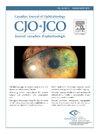葡萄膜炎何时进行二线检查以及进行哪种检查--三级医疗中心的经验。
IF 2.8
4区 医学
Q1 OPHTHALMOLOGY
Canadian journal of ophthalmology. Journal canadien d'ophtalmologie
Pub Date : 2024-08-11
DOI:10.1016/j.jcjo.2024.07.019
引用次数: 0
摘要
目的:葡萄膜炎是由各种病因引起的炎症性疾病。目前,一线病因检查的规范性还很差,有些患者需要进行连续检查。然而,是什么导致临床医生进行后续检查以及这些检查的相关性仍有待确定。本研究的主要目的是评估葡萄膜炎患者二线检查的相关性和方式:我们在南锡大学医院进行了一项单中心回顾性研究。研究对象包括2014年1月至2021年12月期间在内科接受病因检查的所有成年患者:结果:在纳入的 247 名患者中,52 人接受了二线检查,其中 18 人(34.6%)的诊断有所改变,主要是肉样瘤病、眼内淋巴瘤和克罗恩病。多变量分析显示,随访时间超过 40 个月和特发性葡萄膜炎与二线检查的实现有关(OR = 2.97 [1.58 - 5.61]; p = 0.001,OR = 6.13 [2.3-16.1]; p < 0.01)。合眼和眼肉芽肿的存在与诊断的改变有关(OR = 8.03 [1.85-45.48];p = 0.01 和 OR = 5.14 [1.22-24.78];p = 0.03):多达三分之一的患者需要进行二线检查,主要是在出现眼科检查改变、眼裂和肉芽肿特征时,应重点检查眼内淋巴瘤、肉样瘤病和克罗恩病。需要进行更大规模的研究,为二线检查提供指导。本文章由计算机程序翻译,如有差异,请以英文原文为准。
When and which second-line workup to perform for uveitis: a tertiary care center experience
Objective
Uveitis are inflammatory disorders of various etiologies. The first-line etiological workup is currently poorly codified, and some patients undergo sequential investigations. However, what leads the clinician to perform subsequent exams and the relevance of such exams remain to be determined. The main objective of the study was to evaluate the relevance and modalities of a second-line workup of patients with uveitis.
Materials and Methods
We performed a monocentric retrospective study in Nancy University Hospital. All adult patients who underwent an etiological workup in the Internal Medicine Department between January 2014 and December 2021 were included.
Results
Among the 247 patients included, 52 underwent a second-line workup, resulting in a modified diagnosis for 18 of them (34.6%), mainly sarcoidosis, intraocular lymphoma, and Crohn's disease. On multivariate analysis, a follow-up longer than 40 months and idiopathic uveitis were associated with the realization of a second-line workup (OR = 2.97 [1.58 – 5.61]; p = 0.001, and OR = 6.13 [2.3–16.1]; p < 0.01, respectively). The presence of synechia and ocular granuloma were associated with a modification of the diagnosis (OR = 8.03 [1.85–45.48]; p = 0.01, and OR = 5.14 [1.22–24.78]; p = 0.03, respectively).
Conclusion
The second-line workup is relevant in up to one-third of patients, mainly if presenting with a modification of ophthalmological examination, synechiae, and a granulomatous feature, and should focus on intraocular lymphoma, sarcoidosis, and Crohn's disease. Larger studies are needed to provide guidelines for second-line workup.
Objectif
Les uvéites sont des atteintes inflammatoires d’étiologies diverses. À l'heure actuelle, le bilan étiologique de première intention est mal codifié, de sorte que certains patients doivent subir des examens subséquents. Or, on ignore toujours ce qui incite le médecin à réaliser ces examens supplémentaires, de même que la pertinence de tels examens. Notre étude avait pour objectif principal de déterminer la pertinence et les modalités d'un bilan de deuxième intention en présence d'uvéite.
Matériel et Méthodes
Dans le cadre de notre étude rétrospective réalisée exclusivement au Centre Hospitalier Régional et Universitaire de Nancy, tous les patients d’âge adulte qui ont subi un bilan étiologique au service de médecine interne entre janvier 2014 et décembre 2021 ont été inclus.
Résultats
Parmi les 247 patients inclus, 52 ont fait l'objet d'un bilan de deuxième intention. Celui-ci a donné lieu à une révision du diagnostic dans 18 cas (34,6 %), dont la plupart se sont avérés être des cas de sarcoïdose, de lymphome intraoculaire et de maladie de Crohn. Selon l'analyse multivariée, un suivi de plus de 40 mois et la présence d'une uvéite idiopathique étaient associés à la réalisation d'un bilan de deuxième intention (rapport de cotes [RC] : 2,97 [1,58–5,61]; p = 0,001 et RC : 6,13 [2,3–16,1]; p < 0,01, respectivement). La présence d'une synéchie et d'un granulome oculaire était associée à une modification du diagnostic (RC : 8,03 [1,85–45,48]; p = 0,01 et RC : 5,14 [1,22–24,78]; p = 0,03, respectivement).
Conclusion
Le bilan de deuxième intention est pertinent chez près du tiers des patients, surtout en présence d'une modification des résultats de l'examen ophtalmologique, d'une synéchie ou d'un granulome. Un tel examen doit rechercher un lymphome intraoculaire, une sarcoïdose ou une maladie de Crohn. Des études de plus grande envergure permettront d’élaborer des lignes directrices visant l'exécution d'un bilan de deuxième intention.
求助全文
通过发布文献求助,成功后即可免费获取论文全文。
去求助
来源期刊
CiteScore
3.20
自引率
4.80%
发文量
223
审稿时长
38 days
期刊介绍:
Official journal of the Canadian Ophthalmological Society.
The Canadian Journal of Ophthalmology (CJO) is the official journal of the Canadian Ophthalmological Society and is committed to timely publication of original, peer-reviewed ophthalmology and vision science articles.

 求助内容:
求助内容: 应助结果提醒方式:
应助结果提醒方式:


